|
In 1871 there was
an extensive sale of limits in Muskoka and Parry Sound districts,
fronting on Georgian Bay. The dues at this sale were double those of
the previous one, white pine and red pine being two and one-half
cents a foot, or thirty cents a standard. The area disposed of was
487 miles, and the price was $117,672. A still more extensive sale
was the one which took place in 1872, when 5,301 miles on the north
shore pf Lake Huron was disposed of for $602,665. More than
three-fifths of this area had previously been under license, but,
with the exception of thirty square miles, all had been allowed to
lapse.
Legislation was
enacted gradually settling the settlers’ rights and then came the
great river and stream bill suit. This occurred in 1881, when the
Ontario government passed an act permitting lumbermen on the upper
reaches of streams to use slides and other improvements lower down
upon the payment of reasonable dues. Peter MacLaren, the great
Ottawa lumberman, who had made improvements on the Mississippi River
in Lanark County, claimed the right to prohibit the lumber of the
limit holders above him passing through his improvements. The
Dominion government took the side of Mr. MacLaren and disallowed the
Ontario act, but the case was finally determined in favor of
Ontario, and since then lumbermen have had full right to use
improvements upon paying tolls fixed by law.
In 1887 standing
timber had so increased in value that the dues on sawlogs were
increased to $1 a thousand and upon square timber to two cents a
foot. The ground rent was increased from $2 to $3 a mile. Under
these regulations extensive sales were made on the Muskoka and
Petawawa rivers. A new principle was introduced in 1892 when the
lumbermen were restricted to the cutting of red pine and white pine,
leaving spruce, cedar, hemlock, basswood and other woods to be
disposed of otherwise by the Government. It was under these
regulations that extensive sales were made in the districts of
Nipissing, Algoma, Thunder Bay and Rainy River. The dues were
increased to $1.25 a thousand feet on sawlogs and $25 a thousand
cubic feet on square timbers. Notwithstanding this, higher prices
were realized than ever before. The mileage sold was 633, for which
$2,315,000 was realized, an average of $3,657.18 a square mile.
The fluctuating
state of the trade was shown in a return made to the Ontario
Legislature in 1878 of the sawlogs, square and waney timber cut each
year from 1868 to 1877:

The Commissioner of
Crown Lands figured that the waste of material in the shipping of
square timber instead of sawlogs in the above meant a loss of
revenue of. $3,577,500, or $357,750 a year, and he urged changing
over from square timber to sawlogs.
While for many
years the cry has been heard that Ontario is at the end of her
timber resources, this is not the view taken by certain well
informed men. The late John Bertram, of Toronto, who was one of the
best informed practical lumbermen and foresters in Canada, stated in
an article published shortly before his death that, while there was
a much increased demand for home consumption both in Ontario and in
the prairie country in western Canada, he did not look for an
increase in the quantity sawed in Ontario or Quebec because, “ while
there is a large quantity of pine and spruce still available, the
forests are beginning to show signs of exhaustion, and it is a
fortunate circumstance that many lumbermen are showing interest in
the question of reafforestation. The Ontario government has shown
wisdom in its system of fire ranging and in setting apart forest
reserves in the territory not fit for cultivation. This will prolong
the business indefinitely.” The most noteworthy feature of the
lumber industry of recent years has been its rapid development in
the northwestern portion of the Province. This has been stimulated
by the growing demand for the output in Winnipeg and other parts of
Manitoba, which look to the mills of Rat Portage, Rainy River, Fort
Frances and other centers in the Rainy River district as their
nearest source of supply. The continued migration to the West and
the growth of Winnipeg have given a remarkable stimulus to the
production of lumber in . this portion of Ontario.
The income derived
from timber forms a considerable portion of the revenue of the
Province which, owing mainly to the large receipts from this source,
is in the fortunate position of being entirely free from debt and
able to meet all the expenses of administration, in addition to
spending a great deal of money in public services, such as elsewhere
are sustained wholly by the municipalities, without resorting to
direct taxation. In 1903 the total revenue collected from timber was
$2,307,356, the amount being exceptionally large, however, owing to
the holding of an extensive timber sale, at which high prices were
realized.
The increase in the
value of this source of national wealth of late years was indicated
by the result of this sale, at which about eight hundred and
twenty-six square miles was disposed of. Notwithstanding that the
timber dues were raised to $2 a thousand feet board measure on logs,
and to $50 a thousand cubic feet on square timber, and the ground
rent increased from $3 to $5 a square mile, the amount realized as
bonuses was $3,687,337, or an average of $4,464 a mile. The highest
price paid per mile was $31,500. The new record this sale
established as to the great and increasing value of the pine-bearing
lands of Ontario has contributed much to educate public opinion as
to the need of forest preservation and to strengthen the hands of
the Government in its policy in that regard.
The total area now
covered by timber licenses in Ontario is 17,033 square miles, of
which 9,231 are in the western timber district and 6,637 in the
Ottawa district. The total production of sawlogs in 1903 was
679,966,835 feet board measure, of which 549,488,617 came from the
western district as against 104,576,242 from the Ottawa district. In
pine boom and dimension timber the total output was 39,834,442 feet,
the West leading in about the same proportion.
As the entire
forest area of the Province is estimated at 102,000 square miles,1
it will be seen that the territory now under license forms but a
comparatively small proportion of the timber resources yet
available.
It is customary in
taking stock of the available assets in the way of pine timber, to
ignore the territory already disposed of and under license, but some
of this territory has been under license for over forty years, is
still being operated and is contributing yearly to the provincial
treasury, and, so long as this territory escapes the havoc of forest
fires and is free from the settler’s plow, so long will it continue
a source of public revenue.
As to the available
white pine supply in the Province outside the present licensed area,
no attempt at a careful estimate has yet been made. E. J. Davis,
Commissioner of Crown Lands for Ontario, speaking in the legislature
February 18, 1904, gave an estimate prepared by his department. In
this he estimated the amount of white pine still standing in Ontario
at 10,000,000,000 feet, which would suffice for twenty sales such as
that of December 9, 1903, when limits were sold for about $3,500,000
in bonuses. This 10,000,000,000 feet should realize, he said, in
bonuses $75,000,000. The dues had been increased previous to the
last sale from $1.25 to $2 a thousand feet, and the dues on this
pine would produce at least $20,000,000. The surveys of the north
country had shown that there were at least 300,000,000 cords of
pulpwood standing, which, with dues of twenty-five cents a cord (the
present dues are forty cents) would produce $75,000,000 for the
provincial treasury. There was in sight at least $200,000,000 of
revenue, which at $2,000,000 a year would last the Province for one
hundred years. The average revenue in recent years from the forests,
he pointed out, was between $1,250,000 and $1,500,000 a year, of
which $800,000 was dues. This was assuming that the forest was all
used up as time went along; but he then explained what the Province
was doing to keep up a perpetual supply. Passing over the small
timber preserves where the Government, to allow the timber to grow
again, has taken back into possession lands cut over or partly cut
over under licenses, he described the reserves made in the virgin
forest which had been rendered accessible by the building of the new
government railway from North Bay to Lake Temagami and northward.
The original Temagami Reserve around the lake of that name consisted
of 2,200 square miles. This had been increased to 5,900 square miles
and, when he spoke, it had just been decided to set apart 3,000
square miles in Algoma district to be known as the Mississaga
Reserve. The old plan of license by which the lumbermen handed back
the land to the Government when they had cut off the timber was
probably the best that could be devised where the land was arable,
for the Government could then grant it or sell it to the settlers;
but in these reserves where the land is unsuited to agriculture
another plan would have to be devised, which would probably take the
form of a government forester marking the trees to be cut, which
would then be sold by auction, the lumbermen agreeing to cut and
carry away the timber in such a way as to reduce fire risk and give
undeveloped trees a chance to grow. From the cutting of continually
recurring crops of ripe timber on these reserves he anticipated a
revenue of several million dollars a year to the treasury, and
further reserves are to be made from time to time.
In a speech
delivered March 12, 1901, in the Ontario Legislature, Hon. William
A. Charlton (who has since assumed office as commissioner of public
works) stated that the average yearly cut, including logs, boom and
square timber, from 1867 until that date amounted to 549,141,408
feet. The largest cut of any one year was that of 1896, amounting to
952,000,000 feet. He estimated the total quantity of pine timber on
lands then under license at 8,000,000,000 feet, and the quantity not
under license at that time at 26,000,000,000, making in all
34,000,000,000 feet of pine timber then standing. He considered
that, without reference to regrowth or reforestry, the supply was
sufficient to last one hundred and fifty years.
The story of the
westward movement of the trade is told in the report of square miles
under license, although it is to be remarked that an immense area in
the Ottawa district remains under license, showing that much of this
district will permanently remain under timber.
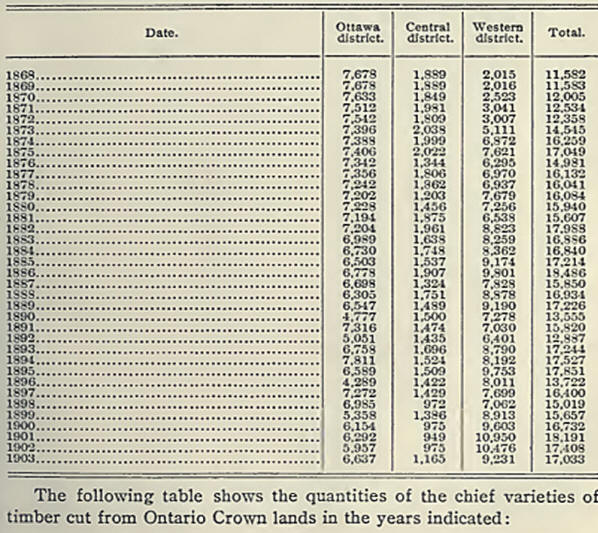
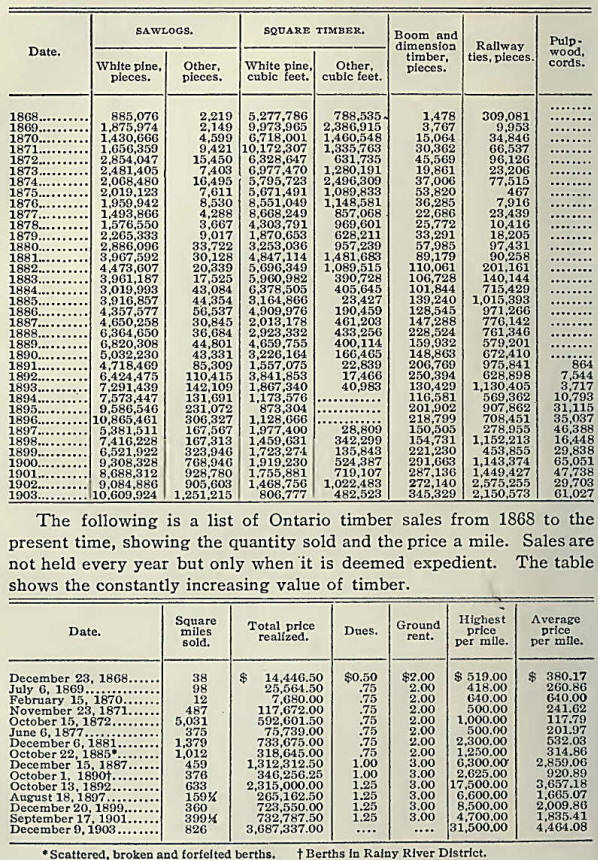
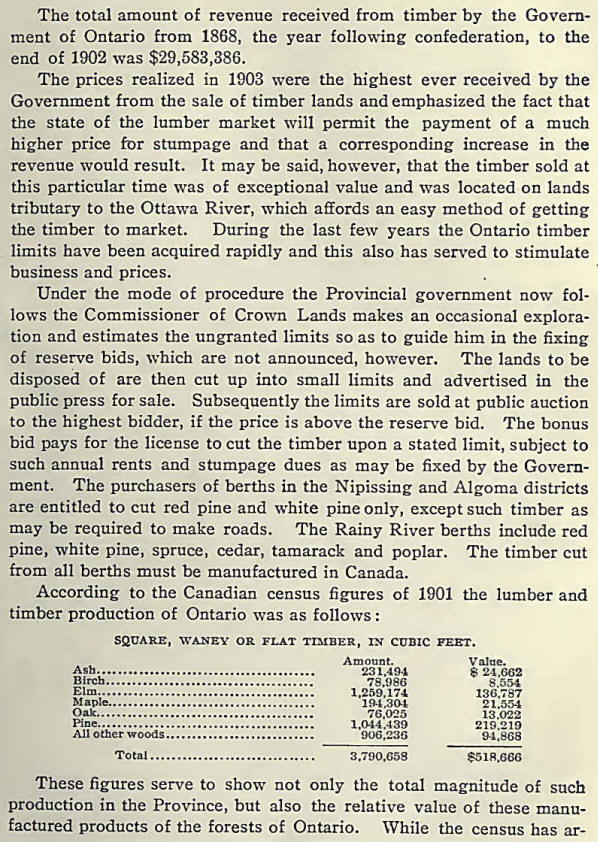
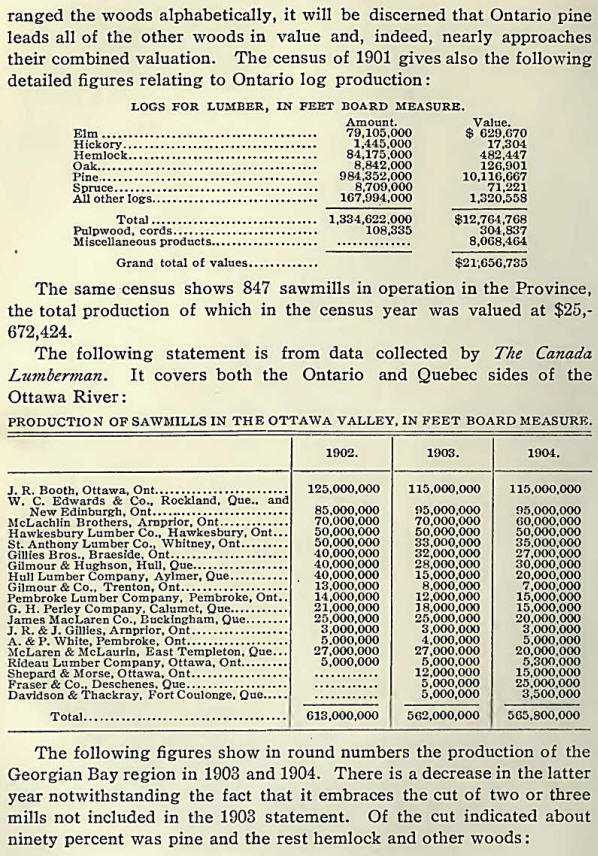
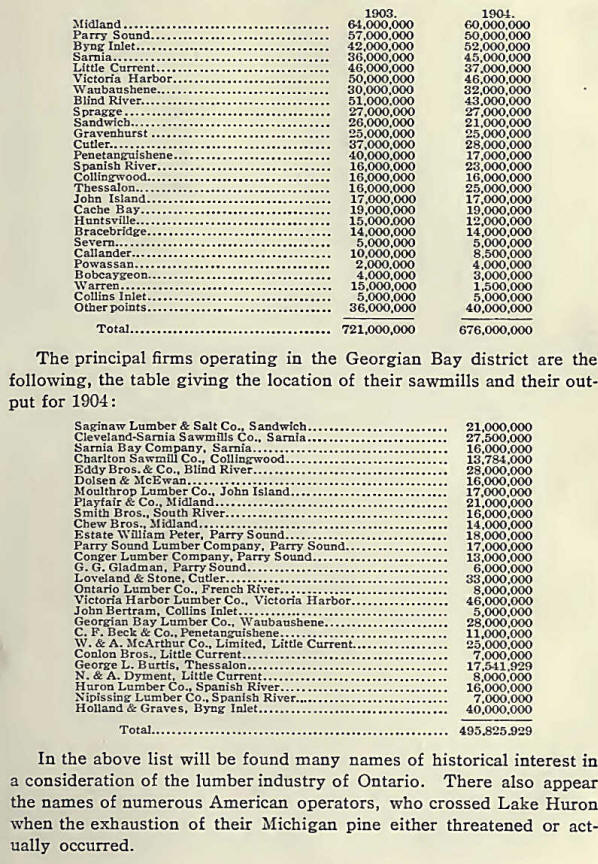
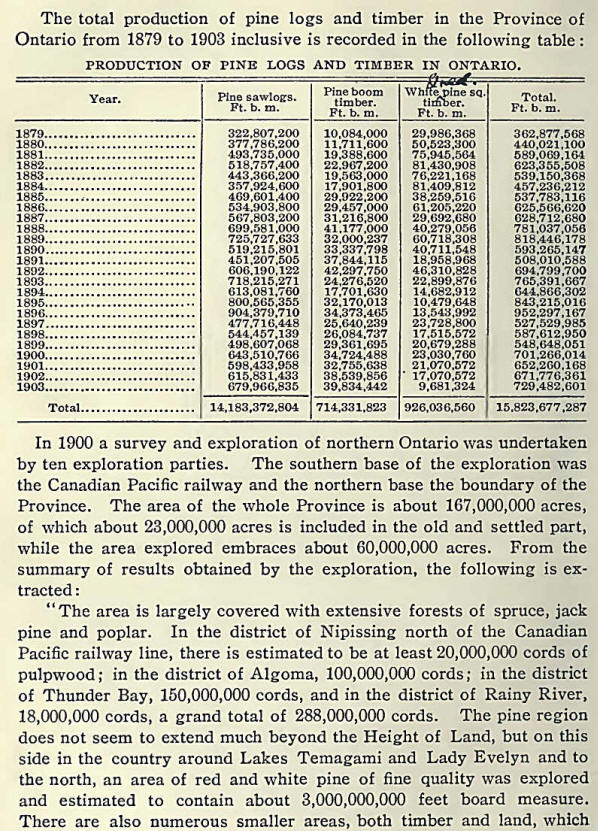
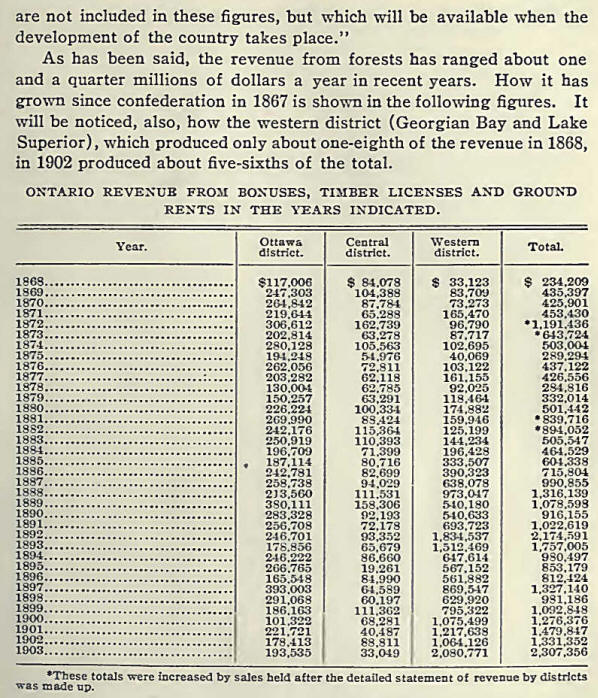 |
